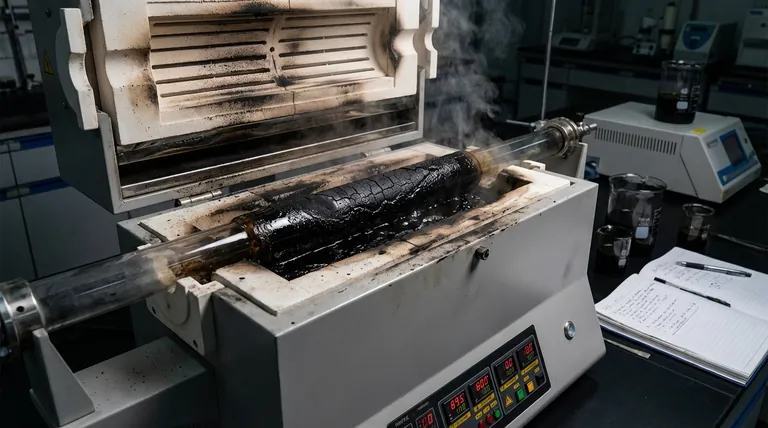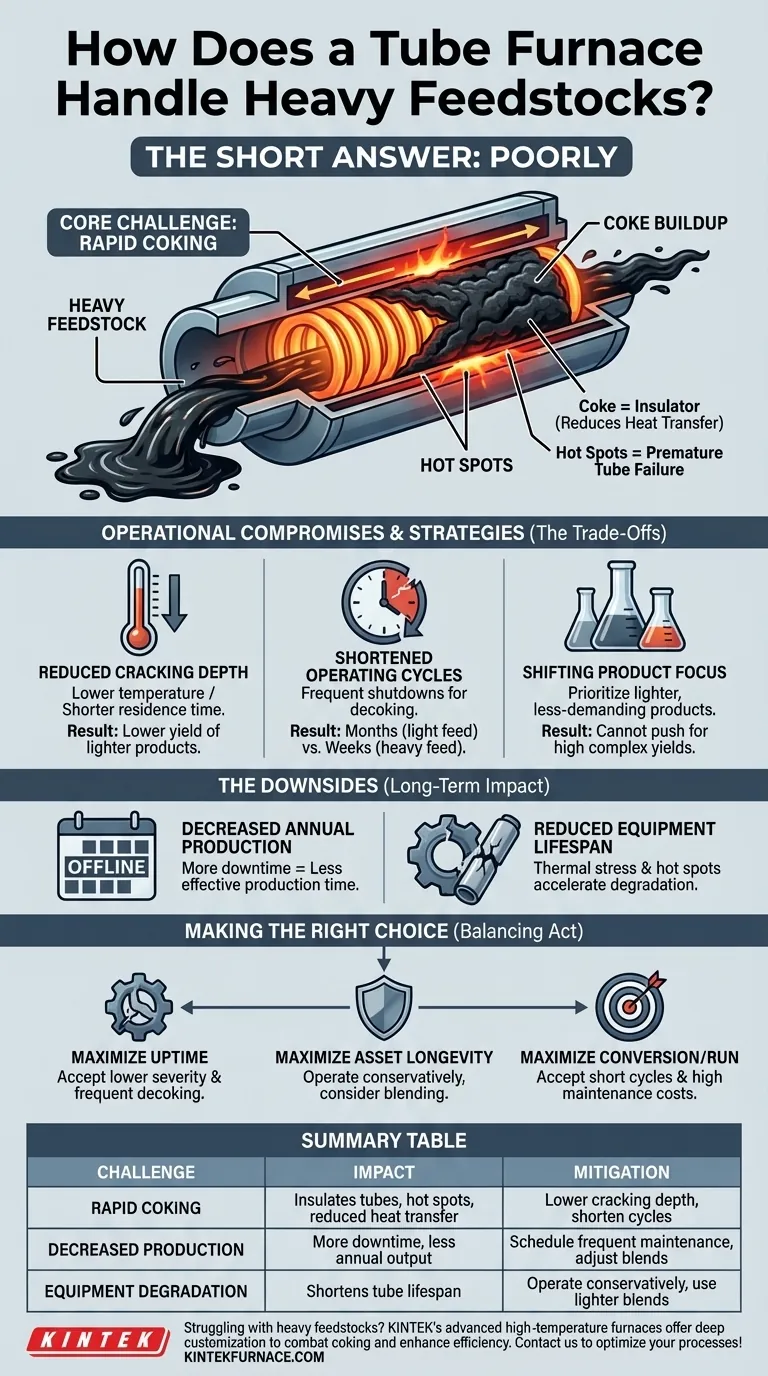In short, a tube furnace handles heavy feedstocks poorly. The inherent properties of heavy feedstocks, particularly their high propensity for coking, create significant operational challenges. These challenges force operators to make substantial compromises that limit production efficiency and accelerate equipment degradation.
The core issue is that processing heavy feedstocks in a conventional tube furnace is a constant battle against coking. This requires sacrificing performance—through shorter run times and less intense cracking—to manage the rapid buildup of coke and preserve the furnace itself.

The Core Challenge: Rapid Coking
To understand how a furnace handles heavy feedstocks, you must first understand the primary problem they introduce: coking.
What is Coking?
Coking is the formation of hard, solid carbon deposits (coke) on the inner surfaces of the furnace tubes. These deposits are a byproduct of the thermal cracking reactions, especially at high temperatures.
Why Heavy Feedstocks Accelerate Coking
Heavy feedstocks are rich in complex, high-boiling-point molecules like asphaltenes and heavy aromatics. These components are precursors to coke and are far more prone to polymerization and dehydrogenation reactions that form solid carbon deposits compared to lighter feeds.
The Consequences of Coke Buildup
Coke buildup acts as an insulator, preventing efficient heat transfer from the furnace to the feedstock inside the tube. To maintain the required process temperature, operators must increase the furnace's external temperature.
This creates localized hot spots on the tubes, reducing their mechanical strength and leading to premature failure. Furthermore, the deposits narrow the tube's internal diameter, increasing pressure drop and restricting flow.
Operational Compromises and Strategies
Because of the rapid coking, operators cannot run the furnace under ideal conditions. They must adapt their strategy in several key ways.
Reduced Cracking Depth
Operators are forced to lower the cracking depth or severity. This is typically achieved by reducing the process temperature or shortening the feedstock's residence time in the furnace. While this slows the rate of coking, it also results in lower conversion of the feedstock into valuable lighter products.
Shortened Operating Cycles
Even with reduced severity, coke buildup is inevitable and rapid. This necessitates much shorter operating cycles. A furnace running a light feedstock might operate for months, while one with a heavy feedstock may require shutdown for decoking every few weeks.
Shifting Product Focus
The combination of lower cracking severity and the nature of the feed often means operators must focus on producing lighter, less-demanding products. Pushing for higher yields of complex molecules would accelerate coking to an unmanageable degree.
Understanding the Trade-offs
The strategies used to handle heavy feedstocks come with significant downsides that impact the entire operation.
Decreased Annual Production
Shorter operating cycles directly translate to more frequent shutdowns for decoking. This dramatically reduces the furnace's annual effective production time, as more days are spent offline for maintenance rather than online producing product.
Reduced Equipment Lifespan
The constant cycling between high operating temperatures and the steam-air decoking process induces significant thermal stress on the furnace tubes. This, combined with the risk of hot spots, shortens the lifespan of the furnace tubes and the overall cracking furnace.
Making the Right Choice for Your Goal
Managing heavy feedstocks requires a clear understanding of your operational priorities, as you cannot maximize all objectives simultaneously.
- If your primary focus is maximizing uptime: You must accept a lower cracking severity and plan for frequent, scheduled decoking cycles to prevent severe coke buildup.
- If your primary focus is asset longevity: You should operate at very conservative temperatures and consider blending heavy feedstocks with lighter ones to mitigate the rate of coking.
- If your primary focus is maximizing conversion per run: You must accept the consequence of extremely short operating cycles and the high maintenance costs associated with accelerated equipment degradation.
Ultimately, handling heavy feedstocks is an exercise in carefully balancing competing operational and financial imperatives.
Summary Table:
| Challenge | Impact | Mitigation Strategy |
|---|---|---|
| Rapid Coking | Insulates tubes, causes hot spots, reduces heat transfer | Lower cracking depth, shorten operating cycles |
| Decreased Production | More downtime for decoking, less annual output | Schedule frequent maintenance, adjust feedstock blends |
| Equipment Degradation | Shortens tube lifespan from thermal stress | Operate at conservative temperatures, use lighter blends |
Struggling with heavy feedstocks in your lab? KINTEK's advanced high-temperature furnaces, including Tube Furnaces and CVD/PECVD Systems, offer deep customization to combat coking and enhance efficiency. Leverage our R&D and in-house manufacturing for tailored solutions—contact us today to optimize your processes and extend equipment life!
Visual Guide

Related Products
- 1700℃ High Temperature Laboratory Tube Furnace with Quartz or Alumina Tube
- 1400℃ High Temperature Laboratory Tube Furnace with Quartz and Alumina Tube
- High Pressure Laboratory Vacuum Tube Furnace Quartz Tubular Furnace
- Split Multi Heating Zone Rotary Tube Furnace Rotating Tube Furnace
- Laboratory Quartz Tube Furnace RTP Heating Tubular Furnace
People Also Ask
- What recent improvements have been made to lab tube furnaces? Unlock Precision, Automation & Safety
- How does a vertical tube furnace achieve precise temperature control? Unlock Superior Thermal Stability for Your Lab
- How do vertical tube furnaces comply with environmental standards? A Guide to Clean, Efficient Operation
- How is a high-temperature tube furnace utilized in the synthesis of MoO2/MWCNTs nanocomposites? Precision Guide
- What safety measures are essential when operating a lab tube furnace? A Guide to Preventing Accidents



















